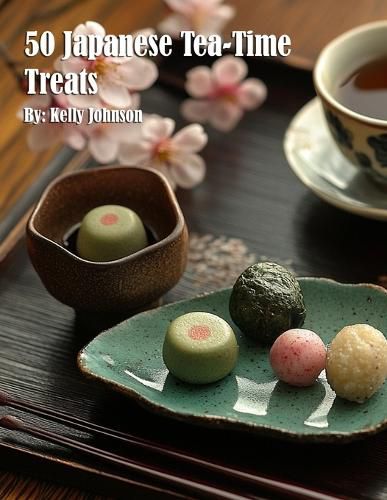Readings Newsletter
Become a Readings Member to make your shopping experience even easier.
Sign in or sign up for free!
You’re not far away from qualifying for FREE standard shipping within Australia
You’ve qualified for FREE standard shipping within Australia
The cart is loading…






This title is printed to order. This book may have been self-published. If so, we cannot guarantee the quality of the content. In the main most books will have gone through the editing process however some may not. We therefore suggest that you be aware of this before ordering this book. If in doubt check either the author or publisher’s details as we are unable to accept any returns unless they are faulty. Please contact us if you have any questions.
Japanese tea-time treats, or wagashi, offer a refined and delicate approach to enjoying tea, with an emphasis on seasonal ingredients and natural sweetness. One of the most iconic sweets is mochi, a chewy, rice-based cake that can be filled with a variety of fillings like sweet red bean paste (anko) or ice cream. Dorayaki, a type of pancake filled with sweet red bean paste, is another beloved treat, often enjoyed with a cup of matcha. Senbei (crispy rice crackers) can be savory or sweet, often flavored with soy sauce, sugar, or seaweed. For those with a preference for traditional sweets, nerikiri (a type of molded, colored sweet) made from sweet bean paste and rice flour is often crafted into beautiful shapes, reflecting the season.
Another popular treat is taiyaki, a fish-shaped pastry filled with sweet red bean paste or custard. Matcha-flavored sweets are a favorite, with matcha mochi and matcha ice cream offering a vibrant, earthy flavor that pairs well with the bitterness of Japanese green tea. Anmitsu, a jelly dessert served with fruit, syrup, and sweet red beans, offers a refreshing treat, especially in the warmer months. Kasutera, a sponge cake brought to Japan from Portugal, is light and sweet, making it a perfect accompaniment to tea. Yatsuhashi, a cinnamon-flavored confection from Kyoto, and kibi dango, chewy rice flour candies, add variety and texture to the range of Japanese tea-time treats. These sweets, often served with sencha or matcha, reflect Japan's cultural reverence for balance, seasonality, and harmony in food.
$9.00 standard shipping within Australia
FREE standard shipping within Australia for orders over $100.00
Express & International shipping calculated at checkout
This title is printed to order. This book may have been self-published. If so, we cannot guarantee the quality of the content. In the main most books will have gone through the editing process however some may not. We therefore suggest that you be aware of this before ordering this book. If in doubt check either the author or publisher’s details as we are unable to accept any returns unless they are faulty. Please contact us if you have any questions.
Japanese tea-time treats, or wagashi, offer a refined and delicate approach to enjoying tea, with an emphasis on seasonal ingredients and natural sweetness. One of the most iconic sweets is mochi, a chewy, rice-based cake that can be filled with a variety of fillings like sweet red bean paste (anko) or ice cream. Dorayaki, a type of pancake filled with sweet red bean paste, is another beloved treat, often enjoyed with a cup of matcha. Senbei (crispy rice crackers) can be savory or sweet, often flavored with soy sauce, sugar, or seaweed. For those with a preference for traditional sweets, nerikiri (a type of molded, colored sweet) made from sweet bean paste and rice flour is often crafted into beautiful shapes, reflecting the season.
Another popular treat is taiyaki, a fish-shaped pastry filled with sweet red bean paste or custard. Matcha-flavored sweets are a favorite, with matcha mochi and matcha ice cream offering a vibrant, earthy flavor that pairs well with the bitterness of Japanese green tea. Anmitsu, a jelly dessert served with fruit, syrup, and sweet red beans, offers a refreshing treat, especially in the warmer months. Kasutera, a sponge cake brought to Japan from Portugal, is light and sweet, making it a perfect accompaniment to tea. Yatsuhashi, a cinnamon-flavored confection from Kyoto, and kibi dango, chewy rice flour candies, add variety and texture to the range of Japanese tea-time treats. These sweets, often served with sencha or matcha, reflect Japan's cultural reverence for balance, seasonality, and harmony in food.